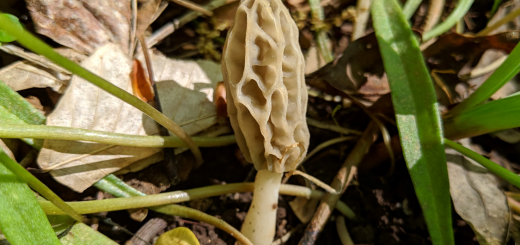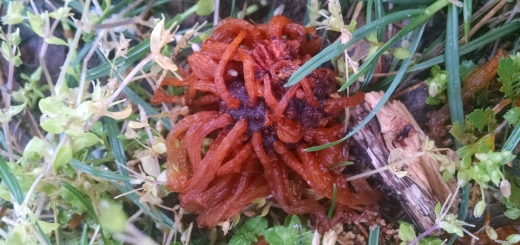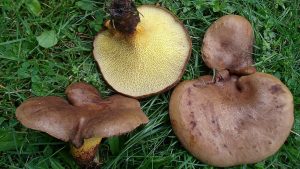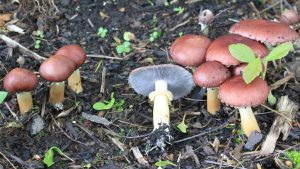#084: Mushroom Paper
Believe it or not, you can use mushrooms to make paper! Mushroom paper uses the same process as normal paper making and only differs in the type of fibers used.
The paper with which you are familiar is made of randomly interwoven cellulose fibers. Cellulose is the main component in plant cell walls, so paper can theoretically be made from any plant material. However, some plants work better than others. Most paper is made from wood because that is the cheapest source of cellulose. Higher quality papers may include cellulose from other plants, like cotton. This can give them a different texture, strength, and other properties (compare money paper to printer paper, for example).
Mushroom paper differs from normal paper in that chitin fibers are used instead of cellulose. Chitin is the main component in fungal cell walls and in the exoskeletons of arthropods (insects, spiders, crabs, shrimp, etc.). Replacing cellulose with chitin in papermaking dates back only to the 1970’s, when people began researching new and different ways to make paper. One of these methods involved using chitin from shrimp exoskeletons.
This caught the attention of Miriam C. Rice, who was experimenting with using mushrooms as dyes. Bits of mushrooms were left over from the dyeing process, and she thought she could recycle these bits by making mushroom paper. After some trial and error, she succeeded. In 1985, she introduced mushroom paper to the world.
Making mushroom paper uses the same process as making normal paper by hand. Today, most papermaking is mechanized, but the principles are the same as in traditional papermaking. The process described below was the method of choice for papermaking up until the Industrial Revolution.
- Pick some mushrooms. Miriam Rice found that tough to woody polypores make the best paper. Some of the best mushrooms for making paper are: Ganoderma species, Fomitopsis species, and Trametes versicolor. These are fairly common finds and a few can be cultivated or purchased commercially. Of course, traditional papermaking uses plants instead of mushrooms. You still have to choose the right type of plant, since some plants work better than others.
- Make the stock. First, you have to soak the mushrooms in water for up to three weeks, changing the water every few days. Once they have been thoroughly soaked, chop them up into small pieces. Finally, put these pieces and some water into a blender and blend until puréed (be kind to your blender during this process). You can also include other materials at this stage for different effects and textures. In normal papermaking, you would have to separate the lignin (which provides the rigidity in wood) from the cellulose at this point. This is done either mechanically or chemically. Fortunately, fungi use only cellulose in their structures, so this step is omitted in fungal papermaking.
- Make the slurry. Once you have made the stock (puréed mushroom), pour it into a basin and add water. You may have to experiment to find the perfect water to stock ratio. This mixture of water and chitin fibers is the slurry. Use your fingers to break up clumps and ensure that the slurry has an even consistency.
- Remove a layer of fibers from the slurry. To do this, you will need a deckle and mold. This can be made by attaching a screen (the “deckle”) to a wood frame (the “mold”). The deckle and mold is lowered into the slurry (deckle on top, mold on bottom) and lifted up to catch some of the floating fibers. You may have to put the deckle and mold in before you add the stock, as the fungal fibers may float. You should keep the screen as level as possible to make sure the paper has an even thickness. If it is not even, quickly tilt the deckle and mold back and forth to spread out the fibers. Let the excess water drip back into the basin.
- Couching (“KOO-ching”). During this step, you remove the paper from the deckle. First, you quickly flip the deckle and mold upside down onto a stack of newspapers, towels, and/or other absorptive materials. Newspaper may impart a gray color to your paper, so you should cover the stack with one or more cloths. Use a sponge to remove excess water and then lift the deckle off the paper. If the paper is too dry, it may rip or stick to the deckle. If this happens, use the sponge to re-wet the paper. When first starting out, try making thicker paper because thin paper will be difficult to work with at this step.
- Dry the paper. Leave the paper on top of the stack of drying materials to dry. To make sure the paper is flat, cover the paper with extra drying materials and put a heavy weight on top. You can help the paper dry faster by gently running an iron over it. If you do this, make sure to cover the paper with a cloth. Change the drying materials every so often to ensure complete drying. When the paper is firm enough, it can be hung on a line to finish drying.
If you make a mistake during this process, the paper can be re-suspended in water and the process repeated. Once you are finished, discard the extra water outside. Do not flush it down the drain as the thick fibers will likely clog the pipes.
What can you do with mushroom paper? It is thicker and stiffer than normal paper, so it is usually used for art projects. And since you’ve made the paper out of mushrooms, why not decorate it using mushrooms? Thanks once again to the work of Miriam Rice, you can decorate your paper using mushroom watercolors and Myco-Stix™ (which are kind of like fungal crayons). If you want to learn more about the artistic uses of mushrooms, consult Miriam Rice’s book, Mushrooms for Dyes, Papers, Pigments, & Myco-Stix™.
See Further:
http://www.fungi.com/blog/items/mushroom-paper.html
http://www.scumsonline.com/_files/PPT/Dyeing%20and%20Paper-Making.pdf
http://sonic.net/~dbeebee/web_mush-history.htm
http://en.wikipedia.org/wiki/Papermaking (for more on standard papermaking)









![#011: Characteristics of Kingdom Fungi [Archived]](https://www.fungusfactfriday.com/wp-content/themes/hueman/assets/front/img/thumb-small-empty.png)



4 Responses
[…] use of this mushroom (at least with the older specimens) would be to make paper out of it (see FFF#084)! The Dryad’s Saddle is one of the few fleshy polypores with which papermaking works well. […]
[…] by Miriam C. Rice, who I have previously mentioned as the inventor of mushroom papermaking (FFF#084). The procedure for mushroom dyeing is pretty much the same as when using other natural dyes: treat […]
[…] Most field guides this mushroom edible, although there does not seem to be a consensus on edibility.1,2,5,13 Mycologist Bill Russell suggests this mushroom is best when young.1 Personally, I do not find the mushroom very appetizing. Its odor – which does not go away when dried – is too unpleasant for me to consider eating the mushroom. Perhaps very young specimens are less smelly. However, L. persicinus does make good (if a bit pungent) mushroom paper (see FFF#084). […]
[…] you’re not into eating mushrooms, you can also use the Dryad’s Saddle to make paper (see FFF#084).1,12 Once again, the younger specimens work best. The young mushrooms create a yellowish paper […]